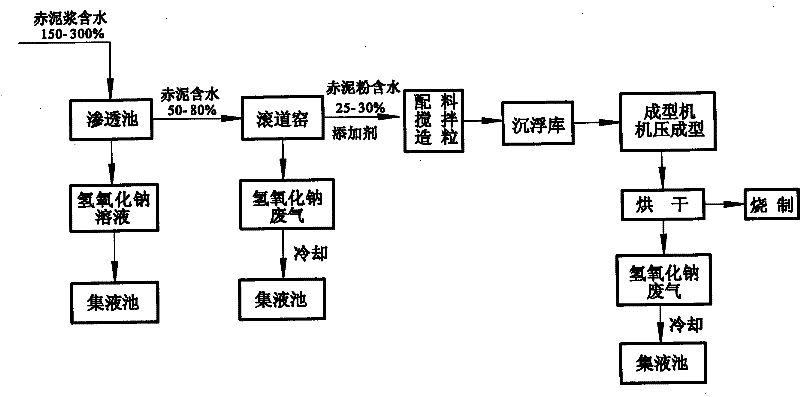Treatment method for recycling waste red mud residues
A treatment method and technology of red mud, applied in the direction of chemical instruments and methods, solid waste removal, application, etc., can solve problems such as unsuccessful development, achieve significant economic and social benefits, and the treatment method is scientific and reasonable, which is beneficial to The effect of environmental protection
- Summary
- Abstract
- Description
- Claims
- Application Information
AI Technical Summary
Problems solved by technology
Method used
Image
Examples
Embodiment 1
[0026] Example 1: A treatment method for red mud waste recycling
[0027] The processing method of red mud waste slag recycling of the present invention, the detailed steps of this processing method are as follows (see attached figure 1 ):
[0028] a. The red mud slurry with a moisture content of 200% transported from the alumina plant through pipeline water is injected into the osmosis tank for initial dehydration, and after dehydration, red mud with a moisture content of 60% and a sodium hydroxide solution with a pH value of 11-12 are obtained (Sodium hydroxide solution penetrates into the diversion channel from the wall and bottom of the permeation tank, and injects it into the liquid collection tank from the diversion channel), injects it into the liquid collection tank, and transports it to the alumina plant for reuse through pipelines;
[0029] b. The red mud obtained after the initial dehydration in step a is sent to the raceway kiln for drying through the conveyor bel...
Embodiment 2
[0033] Embodiment two: basically the same as embodiment one, the difference is:
[0034] In step a: the water content of the red mud slurry transported from the alumina plant is 150%, and the red mud obtained after the initial dehydration in the infiltration tank has a water content of 50%;
[0035] In step c: the amount of additive added accounts for 20% of the total weight of the red mud powder, the additive is a mixture of 8% laterite and 12% fine coal powder, and the granulated mixed material sinks and floats for 6-7 hours at normal temperature in the sink-float storehouse ;
[0036] In step d: the mixed material after sinking and floating is injected into a pressure forming machine according to a conventional method, and pressed into a brick adobe, and stacked for 1 to 3 hours;
[0037] In step e: the red mud brick adobe is dried and heated to 900±5° C. for firing.
Embodiment 3
[0038]Embodiment three: basically the same as embodiment one, the difference is:
[0039] In step a: the water content of the red mud slurry transported from the alumina plant is 300%, and the red mud obtained after the initial dehydration in the infiltration tank has a water content of 80%;
[0040] In step c: the amount of additive added accounts for 10% of the total weight of the red mud powder, the additive is a mixture of 5% laterite and 5% fine coal powder, and the granulated mixed material sinks and floats for 9 to 10 hours at normal temperature in the sink and float store ;
[0041] In step e: after the red mud bricks are dried, the temperature is raised to 950±5° C. for firing.
PUM
| Property | Measurement | Unit |
|---|---|---|
| particle size | aaaaa | aaaaa |
| particle size | aaaaa | aaaaa |
Abstract
Description
Claims
Application Information
 Login to View More
Login to View More - R&D
- Intellectual Property
- Life Sciences
- Materials
- Tech Scout
- Unparalleled Data Quality
- Higher Quality Content
- 60% Fewer Hallucinations
Browse by: Latest US Patents, China's latest patents, Technical Efficacy Thesaurus, Application Domain, Technology Topic, Popular Technical Reports.
© 2025 PatSnap. All rights reserved.Legal|Privacy policy|Modern Slavery Act Transparency Statement|Sitemap|About US| Contact US: help@patsnap.com

